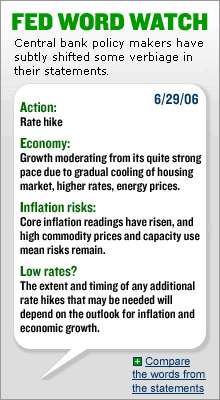Fed hikes rates again Central bank policy-makers raise key rate to 5.25%; some investors see hints of a pause in increases. NEW YORK (CNNMoney.com) -- The Federal Reserve raised rates again Thursday, and Wall Street cheered as some saw hints of a less aggressive central bank. Fed policy-makers boosted their target for the federal funds rates to 5.25 percent, as had been widely expected, putting the overnight bank lending rate at its highest since January 2001.
The quarter-percentage point hike was the Fed's 17th straight rate increase. Another rate hike in August is widely anticipated, but some market watchers said the Fed's statement suggests an end to its now two-year old rate-hiking campaign may be in sight. In its accompanying statement, policy-makers left the door open for more increases but said future moves would depend on economic numbers. (Read the statement) "The extent and timing of any additional firming that may be needed to address these [inflation] risks will depend on the evolution of the outlook for both inflation and economic growth, as implied by incoming information," the central bank said in its statement. That replaced the line from its May 10 statement that said, "The Committee judges that some further policy firming may yet be needed..." The statement suggests this could be the last hike from the Fed, said Keith Hembre, chief economist with First American Funds in Minneapolis. For one thing, the Fed noted that economic growth is slowing. Policy-makers also said that inflation expectations remain contained, which suggests the Fed is focused on taking a more forward rather than backward looking view on inflation, Hembre said. "I see no presumption of a need for additional tightening. The implied likelihood of additional tightening at the next meeting is considerably less with this wording than with prior wording," he said. Interest rate futures on the Chicago Board of Trade indicated that traders lowered their bets on the likelihood of another rate raise in August, to a 72 percent chance, versus 88 percent before this announcement. Stocks, which rose ahead of the announcement, soared afterward, propelling blue chips to their biggest gains in three years in point terms. Several investors have been concerned that the Fed will cripple economic growth - and corporate profits - by raising interest rates too high. Bonds, which also were higher before the statement, held steady, with the yield on the benchmark 10-year note at 5.21 percent. A less aggressive Fed? To be sure, inflation was still on the mind of Ben Bernanke and Co. - the central bankers said in their statement that "some inflation risks remain." But the statement shows that the Fed under new chairman Ben Bernanke is focused on fighting inflation, but not at all costs, according to Michael Cheah, portfolio manager at AIG SunAmerica Asset Management. "They clearly showed they are cognizant of the fact that growth is moderating. They're very clearly saying that nothing is set and that future moves depend on the numbers," he said, referring to additional rate hikes. One Fed watcher, however, said it's unrealistically optimistic to expect the central bank will now pause after its two-year rate hiking campaign. "We're definitely moving down the path of additional hikes," said Keith Stock, president of MasterCard Advisors, the consulting arm of MasterCard International. The economy continues to show strength, and the Fed expressed concern about rising energy and wage costs in its statement, he said. The overall tone of the statement, however, suggests that the Fed is trying to look for a point to stop, according to Kevin Giddis, managing director of fixed income at Morgan Keegan. "If the inflation outlook doesn't remain contained, the Fed could go up to 5.5 percent. But between now and the next meeting, [the economic numbers] could also cause them to pause," he said. Nervousness over rates and the economy sparked a major sell-off in stock markets worldwide in May. For consumers, the fed funds rate affects rates on a variety of loans, including credit cards and corporate loans. The rate was at its lowest in more than 40 years when the Fed began raising rates two years ago in a bid to ward off inflation. |
| ||||||||||||


